Many folks have never seen or heard of the cauliflower mushroom before landing upon this article. It’s not surprising, as you generally won’t find the funky fungi in grocery stores. Nor will you find them available for order online without some specific looking for it. If you search “edible wild mushrooms” it’s also not going to be top of or even included in many lists.
However, the unique mushroom that does somewhat look like cauliflower is a flavorful option worth considering for your dining and foraging adventures.
Let’s take a look.
Classification
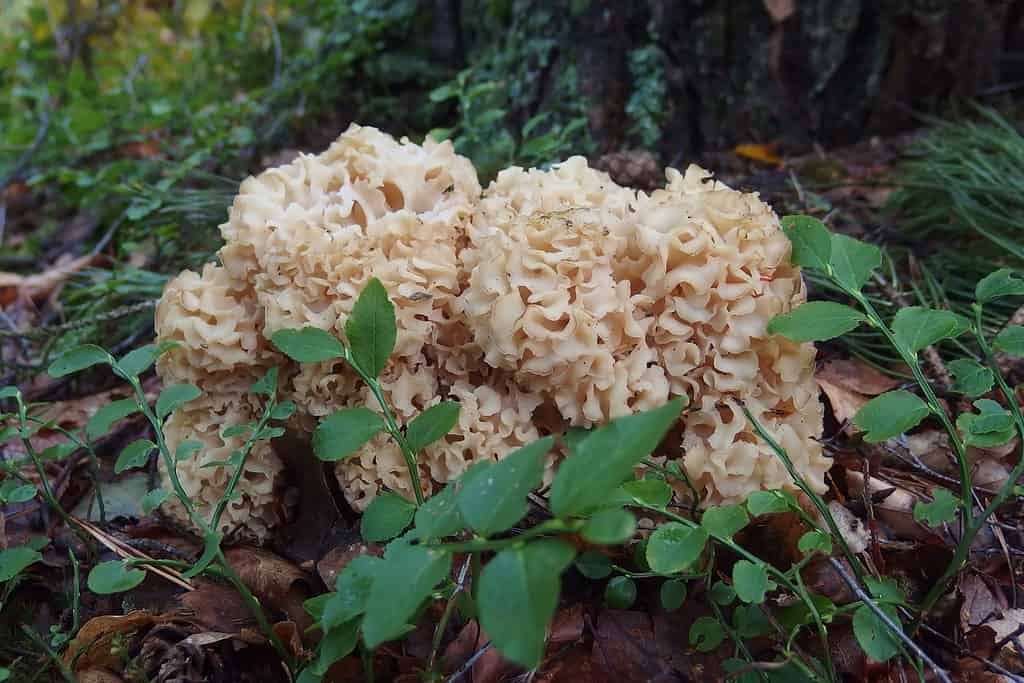
Cauliflower mushrooms growing in the woods – notice the tree base just behind.
©iwciagr/Shutterstock.com
The cauliflower mushroom, commonly described as looking like a sea sponge, brain, or, of course, cauliflower, is dubbed with the scientific names Sparassis crispa, Sparassis americana, Sparassis brevipes, Sparassis spathulata or Sparassis radicata. These fungi are part of the genus Sparassis. They can all go by the same common name, even though they are all distinct species. They are parasitic, meaning they “latch” onto organisms and feed off of them, and saprobic, meaning they feed off of dying or decaying matter. In this case, it’s trees that the mushrooms latch onto. They belong to the Sparassidaceae family. These mushrooms are also known as rooting cauliflower mushrooms, noodle mushrooms, wood cauliflower and in the culinary world “egg noodle of the woods.”
Where Do Cauliflower Mushrooms Grow?
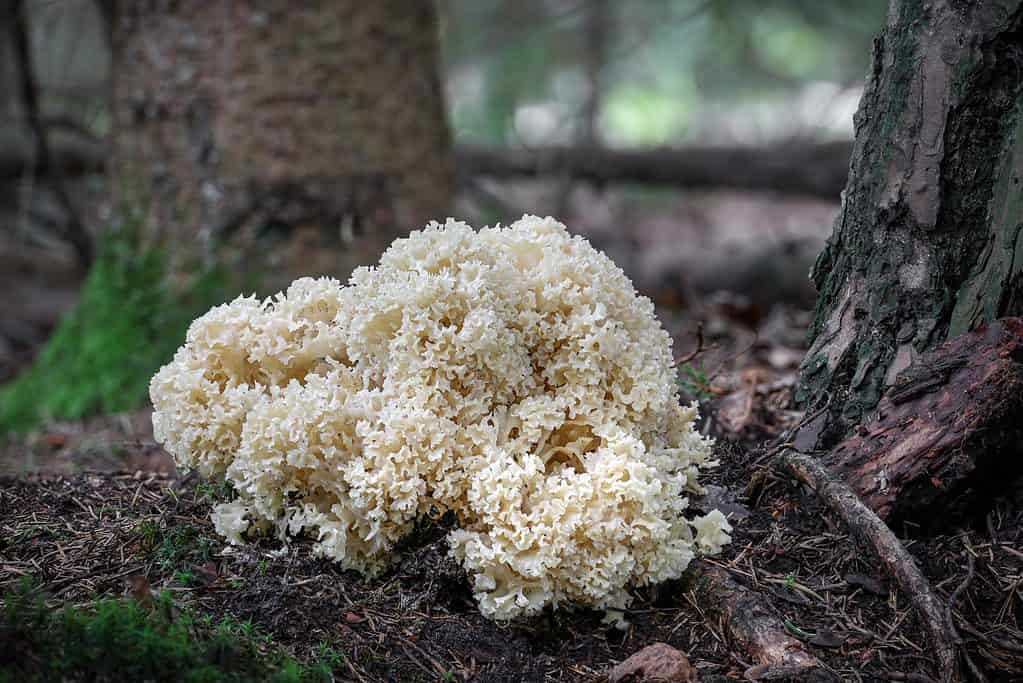
Though they’re technically parasites, cauliflower mushrooms grow at the base of trees, not on the trunks.
©Jaroslav Machacek/Shutterstock.com
This unique fungus is found all over the world, largely in Europe and North America, Australia, Japan, and Korea. Sparassis species are supposedly is being cultivated in Japan, Korean, the United States, and Australia, but it is still unlikely to be found in markets and farmer’s markets in these regions unless it was foraged from the wild.
You’ll find different species of this mushroom around different trees. Sparassis crispa is associated with Scots pine, Sparassis americana is found around multiple species of pine in the U.S.A., while Sparassis spathulata is normally found around hardwoods, but occasionally found around pine.
Are Cauliflower Mushrooms Safe to Eat?
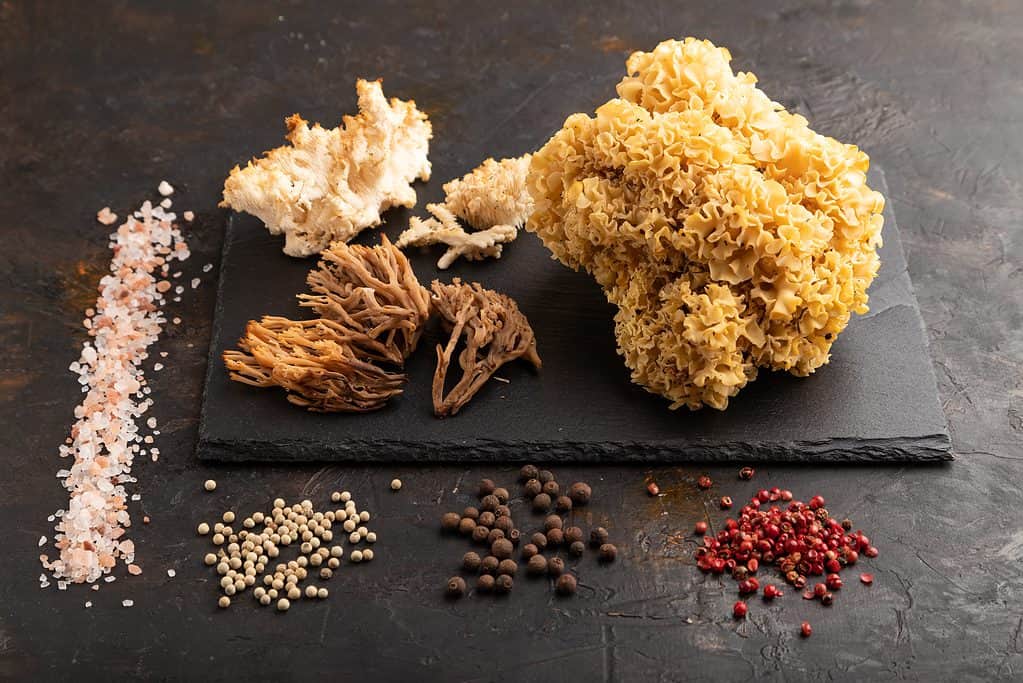
Cauliflower mushrooms and edible and delicious, though somewhat rare.
©uladzimir zgurski/Shutterstock.com
A tasty favorite for texture and uniqueness, cauliflower mushrooms are very definitely edible. Sparassis crispa is the most well known species, so you will find more recipes with it than the others mentioned in this article.
Any time you prepare cauliflower mushrooms, be sure to thoroughly wash the entire fungus as the folds often contain dirt, pine needles, seeds, and other forest debris that may not be so tasty.
It’s also recommended that these mushrooms are only eaten when creamy white, as the darker shades into yellow means that it is past its peak and basically inedible. Many mushrooms, including this one, may be dried and kept for later.
What Do Cauliflower Mushrooms Taste Like?
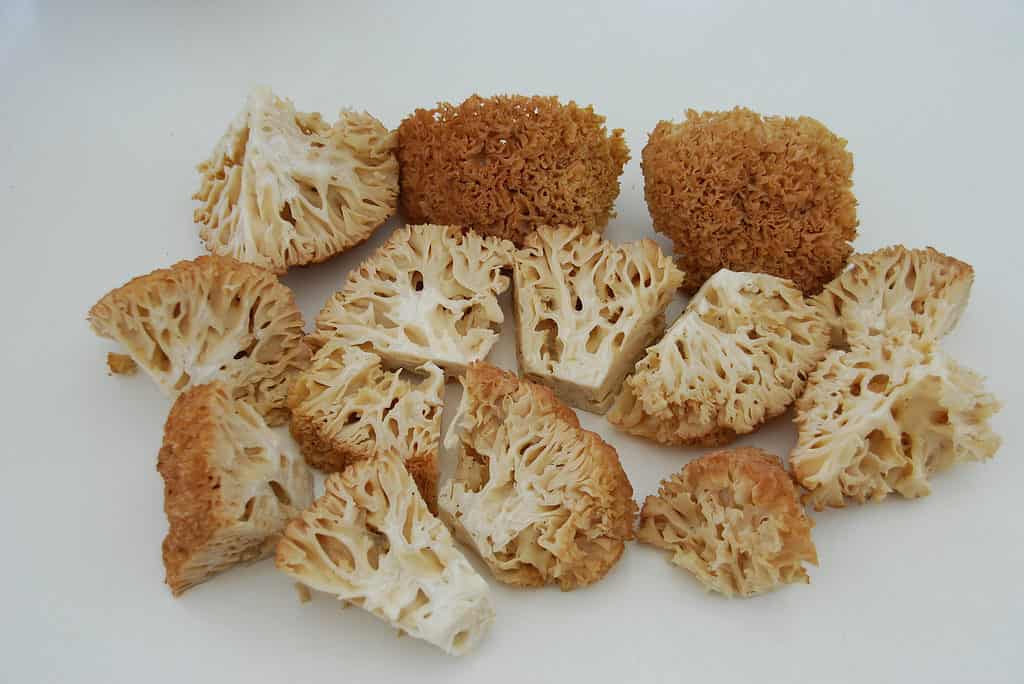
You can easily see where the fungus gets its name.
©petratrollgrafik/Shutterstock.com
The mushroom is a cap-less species of fungus, made up of frilled leaf-like branches that cluster and emerge from the base, much like a cauliflower or broccoli plant. The mushrooms tend to be semi-firm, a bit brittle, and yet chewy texture to them and when raw smell earthy and musky. When cooked, they’re much more neutral in flavor, described as slightly nutty, with notes of fennel and almond. Many people describe them as and use them in dishes as a noodle substitute.
How Do people Use Cauliflower Mushrooms?
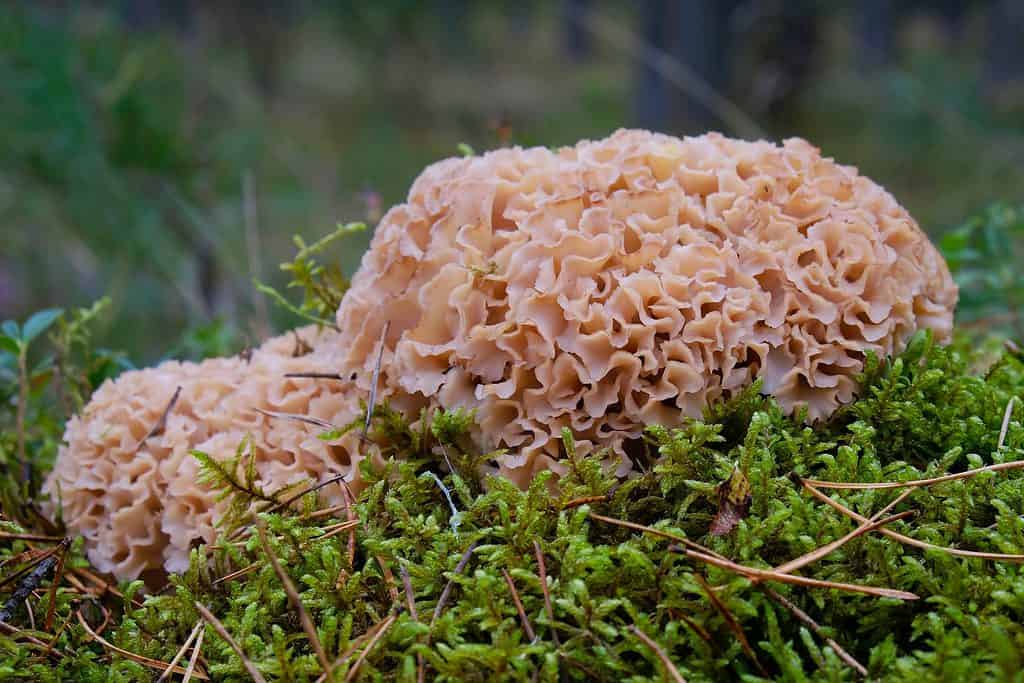
These mushrooms are prized in the culinary world and may also have medicinal value in nature.
©iwciagr/Shutterstock.com
Cauliflower mushrooms are a favorite among those who’ve found and used them before, thanks to its unique texture and flavors. Cooks use the mushroom in many recipes, traditional and new, including quiches, soups, stews, skillets, risotto, stir fries, mushroom bakes, and as vegan alternatives for meat in recipes like “steaks,” crumbles, and even as burger replacements.
Health Benefits
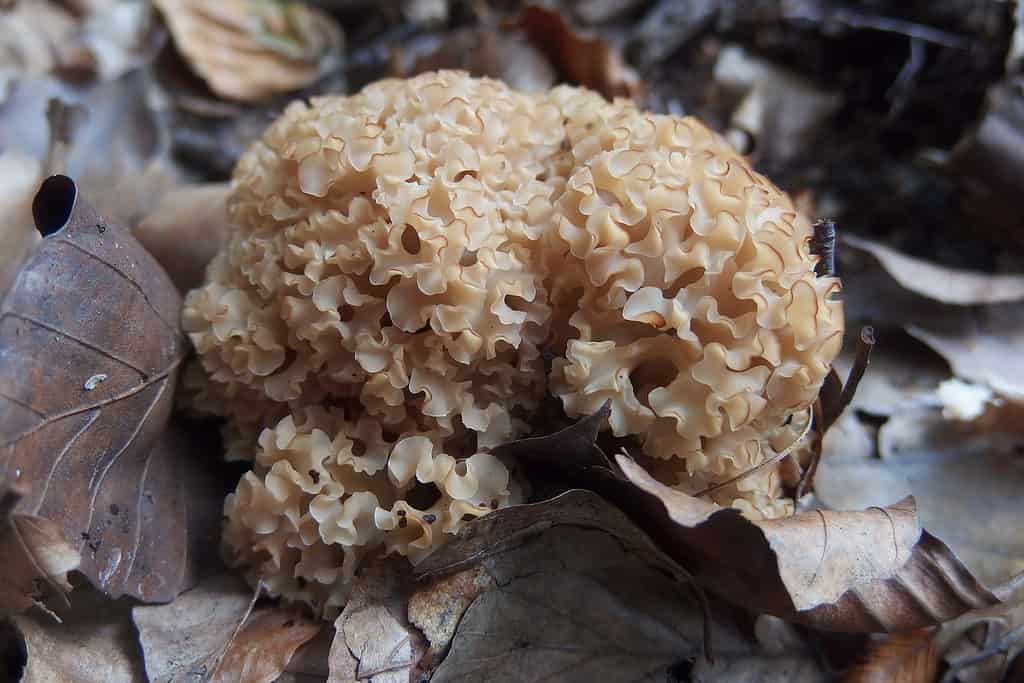
They thrive among the rich compost of fallen leaves at the bases of hardwoods and conifers.
©iwciagr/Shutterstock.com
Cauliflower mushrooms are used in foods for obvious reasons – the unique texture, delicious and distinctive flavors, the novelty, even. This mushroom has also widely been used in traditional Chinese medicine for centuries. These species contain active pharmacological ingredients that have spurred scientific research into the possibility of medicinal benefits as well. The mushrooms contain Beta-glucans, which is an approved cancer treatment in Japan.
Though these mushrooms may have great properties that could certainly boost your health, you should never go off your medications without consulting a medical care provider.
How Much Do Cauliflower Mushrooms Cost?
Cauliflower mushrooms can somewhat expensive, which is, perhaps, largely why they are difficult to find in average grocery stores. They are normally sold by the pound and often range from $20-40+ per pound, depending on season, location, and current availability.
How to Identify Cauliflower Mushrooms
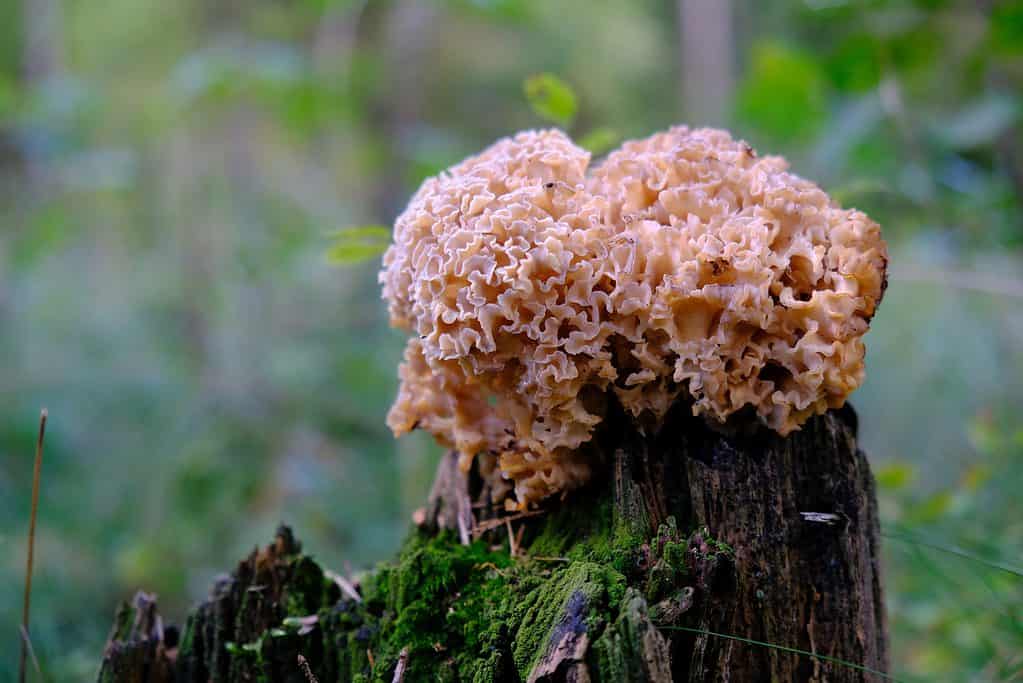
They’ll typically grow at the base of trees, but sometimes they’ll pop up on stumps as well.
©iwciagr/Shutterstock.com
This mushroom is fairly easy to identify and, thankfully, there are no poisonous mushroom lookalikes. Irpex rosettiformis can look extremely similar, but is smaller and normally found in warmer climates. There are also coral mushrooms which may look similar to the untrained eye. It’s always best to consult with an expert before eating wild mushrooms.
Cauliflower mushrooms fit their name very well. They look like weirdly located wild cauliflower, growing on trees and among roots. These mushrooms are white and creamy colored when they’re ready to harvest, and look like a brain, or sea sponge, as noted above. They are, unfortunately, not particularly easy to find, as they’re scarce in most parts of the world, despite technically being available all over.
Some quick identification facts:
- They particularly love pine trees and stumps in the United States
- When they’re ready to harvest, they’ll be a pale cream to a light brown color
- They only grow at the base of trees, not on standing trunks
How to Forage for Cauliflower Mushrooms

Be sure to cut mushrooms, never uproot them. Otherwise, they might not grow back.
©Dorota Szymczyk/Shutterstock.com
Whether you’re on the hunt for moderately easy to find mushrooms like chanterelles or the more difficult cauliflower mushroom, the first important thing to pay attention to is being able to safely and correctly identify any mushroom. We highly recommended that you join a local mycological society or find an expert to teach you. There are some great regionally based books these days to look for the details that can distinguish the cauliflower mushroom from similar looking mushrooms.
The cauliflower mushroom typically grows to between 6 and 8 inches in diameter, but it may be smaller, depending on where it “tucks” itself in for growing. They like hardwoods and conifer trees, particularly oaks, firs, spruce, and pine, so where these trees grow, you’re more likely to happen across these mushrooms in the wild.
When you go to look for these glorious mushrooms, be sure to bring along the right supplies:
- A large basket – these mushrooms typically weigh between 1 and 10 pounds each, with the monsters coming in at possibly much larger.
- A knife or shears for cutting the mushrooms out – don’t pull them up by the base. Some people say they are more likely to grow back when properly harvested.
- A magnifying glass – This can help you distinguish specific details in case you think you might have found a look alike mushroom.
- A notebook and pen – for recording locations and making notes
- Waterproof shoes and clothing – Mushrooms love moist environments.
- A GPS-enabled phone – so you can find your way back to car and so you can mark the spot for returning year after year.
Become an “Expert” in Cauliflower Mushrooms
Because the mushroom is rare and can sell for a hefty price, you will likely want to be able to find these fungi on your own to save some money. Or, you might even want to harvest and bring to farmer’s markets and local fairs where you can fetch a pretty penny for them where it is legal to sell them.
Becoming an amateur expert on cauliflower mushrooms specifically could help make that come true for you and yours. Study up on the mushroom with all the expert books, join a foraging club to learn more, ask a mycologist questions, and take plenty of notes of locations, specimens, and more as you go forage for yourself.
Look For Mushrooms After Heavy Rains
Like with other species of mushrooms, the cauliflower mushroom thrives in moist environments and loves a post-rainy-day climate. Get out early and start looking for the best results.
Cauliflower Mushroom Trivia

Bring along the right supplies for foraging, including a big basket.
©iwciagr/Shutterstock.com
There are a few different mushrooms labeled as cauliflower mushrooms, and they are all edible. The two most commonly written about are S. crispa and S. radicata. Foragers often will avoid revealing the locations of these particular mushrooms – or may even take to camouflaging their locations – to avoid others from uprooting the mushrooms and preventing them from growing back year after year.
The photo featured at the top of this post is © iwciagr/Shutterstock.com
The information presented on or through the Website is made available solely for general informational purposes. We do not warrant the accuracy, completeness, or usefulness of this information. Any reliance you place on such information is strictly at your own risk. We disclaim all liability and responsibility arising from any reliance placed on such materials by you or any other visitor to the Website, or by anyone who may be informed of any of its contents. None of the statements or claims on the Website should be taken as medical advice, health advice, or as confirmation that a plant, fungus, or other item is safe for consumption or will provide any health benefits. Anyone considering the health benefits of particular plant, fungus, or other item should first consult with a doctor or other medical professional. The statements made within this Website have not been evaluated by the Food and Drug Administration. These statements are not intended to diagnose, treat, cure or prevent any disease.
Sources
- I Naturalist, Available here: https://www.inaturalist.org/taxa/63020-Sparassis
- First Nature, Available here: https://www.first-nature.com/fungi/sparassis-crispa.php
- Specialty Produce, Available here: https://specialtyproduce.com/produce/Cauliflower_Mushrooms_730.php
- Forager Chef, Available here: https://foragerchef.com/cauliflower-mushrooms-sparassis/
- Wild Food UK, Available here: https://www.wildfooduk.com/mushroom-guide/cauliflower-fungus/
Thank you for reading! Have some feedback for us? Contact the AZ Animals editorial team.






